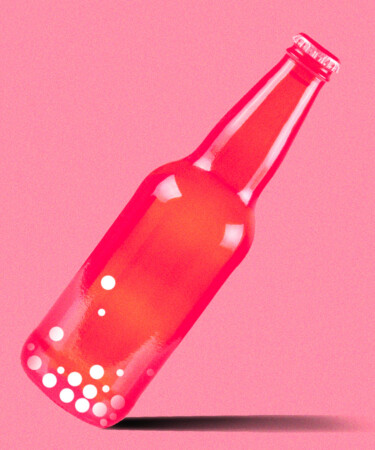Whether it be the hop resins at the bottom of an IPA, the yeast at the bottom of a saison, or the wheat floating around in a hefeweizen, most beer drinkers have been faced with a millimeter of sketchy-looking dregs sitting in their glass. Dregs — the word alone just sounds gnarly. Admittedly, they’re not the prettiest part of a pour, and they don’t taste great, either. There’s even a rumor flying around the Reddit community that dregs can sabotage your GI tract — or, in simple terms, give you the sh*ts.
But as it turns out, dregs aren’t actually as menacing as they sound. To get to the bottom of this misconception, we consulted with Joe Grimm, co-founder of Brooklyn’s Grimm Artisanal Ales and Tim Crook, co-founder of Portland, Ore.’s Nebuleus Beer.
Is it safe to drink beer dregs?
Yes, it’s fine to drink the stuff hanging out on the bottom of the bottle.
“It doesn’t give you the sh*ts. That’s preposterous,” Grimm says of brewing byproduct. “That’s where a bunch of the good B complex vitamins live.” And it’s true: Most brewer’s yeast is rich in vitamins. This doesn’t apply to hop particulates like one would find floating around in an unfiltered IPA like Heady Topper — we’re talking about the yeast, which tends to pile up at the bottom of saisons, mixed culture beer, and spontaneously fermented brews.
Many of these beers are unpasteurized, which means the yeast is still salvageable to the point that homebrewers can even use bottle dregs to kickstart another batch. Pasteurized beer tends to be low on the dreg-o-meter. “Books like ‘Nourishing Traditions’ and ‘Deep Nutrition’ have sung the praises of beer for a long time,” Grimm says, “the caveat being that you want unfiltered, unpasteurized beer with yeast and enzymes intact.”
In terms of flavor, though, a slug-sized clump of yeast in it isn’t generally going to enhance the taste of any brew (with an exception, but more on that later). Unlike wine aged on the lees, beer isn’t intentionally given extra contact with its dregs to enhance its complexity. Grimm admits that dregs “may not be to your taste,” and Crook — who mainly deals with saisons — echoes the notion.
“I think the dregs muddle the flavor,” he says. “We encourage people to chill our bottles upright in the fridge for 24 hours before opening and leave all of the dregs behind,” just like one would do with an old bottle of wine.
The biggest exception to this method would be wheat beers. In such beers, the yeast and grain proteins help bolster the flavor, but can trickle down into dreg territory.
“We only recommend rousing the dregs if it was a hefeweizen, where it’s part of the desired flavor,” Grimm says. Allagash White, an unfiltered Belgian-style wheat beer, even has instructions to rouse the dregs on its packaging. The brewery also ships its kegs upside down so that bartenders have to flip them before tapping, thus disturbing the dregs.
So, if you’re pouring up a wheat beer, go all-in with the dregs. Otherwise, know that they’re not going to hurt you, but they’re probably not going to make the drinking experience any more enjoyable, either — or that much more nutritious. “We’re not drinking beer for the vitamins,” Crook says.
All that said, we’re not here to judge those who do insist on drinking that bottle to the very last drop. Save for some potential side-eye from your table mates, you and your GI tract should be fine.
*Image retrieved from Reddit user xpkranger on r/beer
